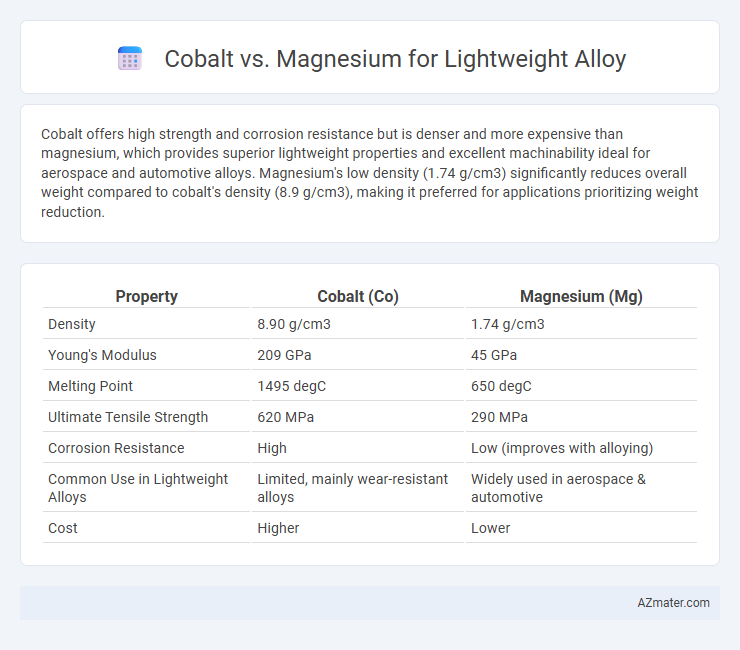Cobalt offers high strength and corrosion resistance but is denser and more expensive than magnesium, which provides superior lightweight properties and excellent machinability ideal for aerospace and automotive alloys. Magnesium's low density (1.74 g/cm3) significantly reduces overall weight compared to cobalt's density (8.9 g/cm3), making it preferred for applications prioritizing weight reduction.
Table of Comparison
| Property | Cobalt (Co) | Magnesium (Mg) |
|---|---|---|
| Density | 8.90 g/cm3 | 1.74 g/cm3 |
| Young's Modulus | 209 GPa | 45 GPa |
| Melting Point | 1495 degC | 650 degC |
| Ultimate Tensile Strength | 620 MPa | 290 MPa |
| Corrosion Resistance | High | Low (improves with alloying) |
| Common Use in Lightweight Alloys | Limited, mainly wear-resistant alloys | Widely used in aerospace & automotive |
| Cost | Higher | Lower |
Introduction to Lightweight Alloys
Lightweight alloys, essential in aerospace and automotive industries, combine metals like cobalt and magnesium to enhance strength-to-weight ratios. Magnesium alloys offer superior lightness with good machinability, while cobalt alloys provide exceptional strength and thermal stability. Selecting between cobalt and magnesium depends on specific application requirements for weight reduction, durability, and cost-efficiency.
Understanding Cobalt and Magnesium
Cobalt and magnesium are critical elements in lightweight alloys, with cobalt offering superior strength, corrosion resistance, and high-temperature stability, making it ideal for aerospace and medical applications. Magnesium stands out for its exceptionally low density, providing significant weight reduction in automotive and electronics industries while maintaining adequate strength through alloying. Understanding their distinct physical and chemical properties helps optimize alloy designs for performance, durability, and weight efficiency in advanced engineering solutions.
Key Material Properties Comparison
Cobalt offers superior wear resistance and higher melting point compared to magnesium, making it ideal for high-temperature applications in lightweight alloys. Magnesium excels in density reduction, being one of the lightest structural metals with excellent machinability and corrosion resistance when alloyed properly. The trade-off between cobalt's durability and magnesium's low weight is critical in aerospace and automotive industries seeking optimized strength-to-weight ratios.
Weight and Density Differences
Cobalt and magnesium alloys differ significantly in weight and density, with magnesium being one of the lightest structural metals at approximately 1.74 g/cm3 compared to cobalt's much higher density of around 8.9 g/cm3. This substantial density difference makes magnesium alloys ideal for applications requiring minimal weight, such as aerospace and automotive industries, where reducing mass improves fuel efficiency and performance. Despite magnesium's advantage in weight, cobalt alloys offer superior strength and corrosion resistance, which may be critical in specific lightweight alloy applications where durability is prioritized over weight savings.
Strength and Durability Factors
Cobalt alloys exhibit superior strength and exceptional wear resistance compared to magnesium alloys, making them ideal for applications requiring high durability under stress. Magnesium alloys are significantly lighter, offering better weight reduction but generally have lower tensile strength and fatigue resistance. Selecting between cobalt and magnesium alloys depends on balancing the priorities of strength and longevity against the critical need for lightweight performance.
Corrosion Resistance Performance
Cobalt-based lightweight alloys exhibit superior corrosion resistance compared to magnesium alloys, particularly in harsh environments with high humidity and salt exposure. Cobalt alloys form stable oxide layers that prevent further oxidation and degradation, enhancing durability in aerospace and medical applications. Magnesium alloys, while lightweight, are more prone to galvanic corrosion, requiring protective coatings to improve their longevity.
Manufacturing and Processing Challenges
Cobalt alloys offer superior strength and corrosion resistance but face higher manufacturing costs and complex processing due to limited ductility and the need for specialized equipment. Magnesium alloys provide significant lightweight advantages with easier casting and machining, yet they present challenges like lower corrosion resistance and difficulties in welding and joining. Balancing these factors, manufacturers must optimize techniques such as powder metallurgy for cobalt and surface treatments for magnesium to enhance performance in lightweight alloy applications.
Applications in Automotive and Aerospace
Cobalt alloys offer exceptional strength, wear resistance, and high-temperature stability, making them suitable for aerospace turbine blades and automotive engine components where durability under stress is critical. Magnesium alloys provide a much lighter alternative with excellent corrosion resistance and good mechanical properties, ideal for automotive body panels and aerospace interior parts where weight reduction is essential for fuel efficiency. The choice between cobalt and magnesium in lightweight alloys hinges on balancing cobalt's superior performance at extreme conditions against magnesium's advantageous weight-to-strength ratio in less demanding structural applications.
Cost and Environmental Impact
Cobalt alloys tend to be more expensive than magnesium alloys due to limited supply and complex extraction processes, driving higher production costs. Magnesium is abundant and cheaper, but its extraction and processing can result in significant environmental degradation, including habitat disruption and CO2 emissions. Both metals face challenges in recycling efficiency, with magnesium offering relatively better energy recovery potential but cobalt's supply source linked to human rights concerns impacting its environmental footprint.
Choosing the Right Alloy for Your Needs
Cobalt alloys offer superior wear resistance and high-temperature strength, making them ideal for aerospace and medical applications where durability is critical. Magnesium alloys, known for their exceptional lightness and good mechanical properties, are preferred in automotive and electronics industries to reduce weight and improve fuel efficiency. Selecting the right alloy depends on balancing weight reduction with strength requirements, corrosion resistance, and application-specific performance criteria.

Infographic: Cobalt vs Magnesium for Lightweight Alloy
 azmater.com
azmater.com